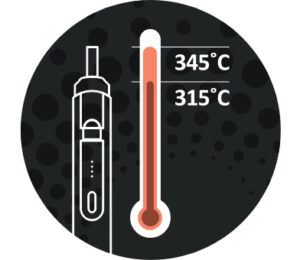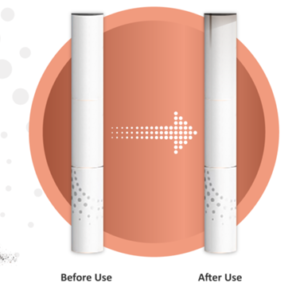Nicotine use independent of combustible tobacco has existed in certain forms, like chewing tobacco and tobacco snus, for centuries. Recent rapid improvements in technology, however, alongside increasing adult smoker demand for harm reduced cigarette alternatives, has resulted in a raft of new nicotine-containing Next Generation Products, or NGPs.
From the emergence of the e-cigarette in 2003 through to more modern innovations like tobacco-free oral nicotine pouches, all these smoke-free NGPs offer exciting harm reduction possibilities for millions of adult smokers worldwide, relative to continued combustible tobacco usage.
Here are nine of the most important innovations so far…
1. Ruyan V8: the modern e-cigarette is born
The American inventor Joseph Robinson proposed an idea that: ‘relates to vaporising devices for holding medicinal compounds which are electrically heated to produce vapors for inhalation’ in 1927, but it took another 80 years for the first true e-cigarette to arrive.

Hon Lik, pioneer of the modern e-cigarette, at a vape manufacturing facility. Image: Imperial Brands
Unlike the medical apparatus or cigar-like incarnations preceding it, the Ruyan V8’s long, thin frame more closely resembled a traditional cigarette. The device relied on propylene glycol (PG) to carry nicotine, mimicking the smoking sensation and even emitting a vapour that resembled cigarette smoke.
With the V8, Chinese inventor Hon Lik – a heavy smoker whose father had died of lung cancer – had created the very first mass-market, potentially harm reduced NGP. Read a Q&A interview with him here.
2. The sub-Ohm coil: clouds on the horizon
First generation e-cigarettes were designed primarily to mimic the look and feel of traditional combustible cigarettes. However, in the early 2010s, a breakthrough in coil technology resulted in the emergence of a new vaping subculture.
The sub-Ohm coil, named after electrical scientist Georg Ohm, powered at a higher wattage to heat a more viscous liquid. It was designed to work with lower nicotine strength e-liquids with a higher vegetable glycerine (VG) to PG ratio.
This innovative pairing resulted in a notable absence of throat irritation and larger plumes of exhaled vapour – which gave rise to the ‘cloud-chasing’ phenomenon.
Sub-Ohm coils also heralded the arrival of a wide range of vape flavours beyond traditional tobacco and menthol, many of which have demonstrably helped to create exciting, personalised journeys for adult smokers transitioning away from cigarettes.
3. Nicotine salts: cigarette-like nicotine delivery
Traditional e-liquids have proved effective in providing some vapers the nicotine they desire, but the pharmacokinetic uptake of freebase nicotine into the body can be relatively slow compared to combusted tobacco smoke.
Not so with innovative nicotine salts, which are slightly different in terms of their chemical composition and stability.
Unlike freebase nicotine, nicotine salts remain in inhaled vape aerosol until it reaches users’ lungs, where it’s absorbed more quickly.
This provides greater satisfaction, which research suggests many vapers find more akin to smoking – hence their importance in helping greater numbers of adult smokers transition to potentially harm reduced NGPs.
4. The pod system: back to basics
When e-cigarettes arrived in Europe and America, they were predominantly pre-filled, cartridge-based systems – like Hon Lik’s aforementioned Ruyan V8. With the sub-Ohm coil revolution, a trend emerged favouring larger tanks. These were necessary to store the greater amounts of e-liquid the enhanced coils rapidly vaporised, to the point where some vape ‘Box Mods’ looked almost unrecognisable compared to traditional e-cigarettes.

Pods allow an easy in-and-out system suited to casual users. Image: Imperial Brands
However, as vaping became more popular among adult smokers, the majority were less interested in tinkering around with e-liquids, understanding the concept of Ohm’s Law or generating huge plumes of vapour. Instead, interest focused on more subtle, convenient vape formats.
Enter the pod system, which was in some sense a return to the simpler systems of vaping’s past, combining a high-quality user experience with ease of use. Merely clicking a pod into place, as opposed to juggling liquid bottles and replacement coils, proved a popular alternative for those adult smokers-turned-vapers who were beginning their journeys away from combustible tobacco.
5. Plant fibres: the genesis of tobacco-free oral nicotine pouches
Tobacco-free oral nicotine pouches are a recent product innovation available in a growing number of countries. While they share the same oral method of use as traditional tobacco-containing Scandinavian snus, they are in fact a completely separate category – and, crucially, don’t contain tobacco leaf.
Instead, pouches contain high purity pharmaceutical grade nicotine applied to plant fibres including bamboo and wheat, as well as other ingredients like flavourings, humectants to retain moisture, and additives to ensure product stability. Placed under users’ lips, the pouches steadily release nicotine into the bloodstream though the gum membranes, rather than via the airways and lungs like other NGPs.
With the initial science suggesting tobacco-free oral nicotine pouches are currently the most potentially harm reduced NGP, it’s clear the category offers compelling tobacco harm reduction (THR) potential.
6. Tobacco-free oral nicotine pouches: flavours and textures
Research – primarily focusing on vaping – has demonstrated flavours play a critical role in moving adult smokers away from combustible tobacco to NGPs.
Tobacco-free oral nicotine pouch flavours offer similar potential, as long as they’re developed and marketed responsibly with only adult smokers in mind.
Scope for further innovation exists beyond flavours too, including the way pouches feels in users’ mouths, in terms of texture, moistness and more.
For instance, a distinction is emerging between ‘moist’ pouches (favoured in Scandinavia) and ‘dry’ pouches which are proving popular in other NGP markets around the world.
7. Heat not burn: the absence of combustion
Science has demonstrated the greatest health risk for adult smokers stems from burning tobacco and inhaling the smoke. It’s the most harmful way to consume nicotine, and a cause of serious disease and preventable deaths.

Heat-not-burn: a reduction of 500 degrees. Image: Imperial Brands
With this now in mind, why not heat tobacco – rather than burn it – to release the nicotine and associated aromas in an aerosol that also contains significantly fewer harmful chemicals than cigarette smoke?
Ostensibly the closest of all NGPs to the traditional cigarette experience, the potential of heated tobacco to help facilitate THR is significant.
For instance in Japan, the world’s largest heated tobacco market, the smoking rate recently dropped to a record low of 16.7%.
8. Device design: features, functionalities and friendliness
As the heated tobacco category gains momentum, device innovation continues at pace. For instance, following the launch of first generation devices manufacturers quickly produced improved models with impressive battery lives, or rubber caps and in-built cleaning equipment to simplify maintenance.

There is more mileage in device design for all NGP products. Image: Imperial Brands
More interesting recent inventions include puff sensors that help create a consistent user experience, as well as signalling when tobacco sticks are coming to an end.
In addition, variable power modes including eco-modes have been developed, which maximise battery life and allow for different user inhalation experiences.
9. Heated tobacco stick innovation: sticking at it
Much of the success of heated tobacco is down to the small sticks of reconstituted tobacco themselves.

Heated tobacco is only as robust as the stick around it. Image: Imperial Brands
The aluminium foil that surrounds them is the first line of innovation, ensuring sticks cannot be misused and smoked like combustible cigarettes. Filters utilise technology like triple bores, which provide a smoother draw alongside a more intense experience.
Meanwhile, optional ‘crushballs’ can release tastes like mint and menthol, reinforcing the importance of flavours in facilitating adult smoker transitioning to NGPs.
Further advances in the manufacture of the reconstituted tobacco used in heated tobacco sticks will also doubtless continue to foster innovation.
Conclusion: regulation nation
These wide-ranging NGP advances all have something in common. They’re borne not only of technological improvements and increasing adult smoker demand, but also of regulatory frameworks that, broadly, have encouraged and facilitated NGP innovation. This is important, because over-regulation stifles continued innovation and ineffective NGPs, which hampers adult smoker uptake and restricts the ensuing public health opportunity.
So here’s to the NGP innovators, including our own R&D arm Nerudia, to the regulatory frameworks that empower them – and to the inevitable future breakthroughs that continue to help facilitate THR and drive better global public health outcomes.
—
You are free to share this content with credit to Imperial Brands under a Attribution-NoDerivatives 4.0 International (CC BY-ND 4.0) license.
